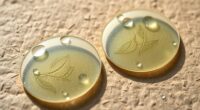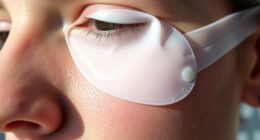When making a DIY eye patch, avoid potent essential oils like tea tree, eucalyptus, and citrus extracts such as lemon or orange—these can cause irritation or allergic reactions, especially around the sensitive eye area. Steer clear of honey, which might trigger allergies, and stay away from artificial fragrances and dyes that can irritate delicate skin. Using gentle, safe ingredients is key—keep exploring to discover safer options for your eye care routine.
Key Takeaways
- Avoid essential oils like tea tree and eucalyptus around the eyes due to allergy and sensitivity risks.
- Refrain from using citrus extracts such as lemon or orange zest, which can cause irritation and photosensitivity.
- Do not include honey or bee products if you have allergies, as they can trigger reactions or sensitivities.
- Steer clear of strong scents, artificial fragrances, and dyes that may irritate delicate eye skin.
- Always perform patch tests and consult a dermatologist before trying any DIY eye patch ingredients.

Creating your own eye patch at home is easier than you might think, especially when you know which natural ingredients can help soothe and protect your skin. However, it’s just as important to be aware of ingredients that could do more harm than good. Many people turn to home remedies for quick relief or to avoid commercial products with questionable chemicals, but some natural ingredients can actually trigger allergies or cause irritation, especially around the delicate eye area. Before you start mixing up your own eye patch, it’s vital to identify ingredients that are best avoided.
Be cautious of natural ingredients that can trigger allergies or irritation around your eyes.
Certain herbs and natural substances, despite their reputation for healing, can act as allergy triggers. For example, some essential oils like tea tree oil or eucalyptus oil are popular in home remedies, but they’re also known to cause allergic reactions in sensitive skin. Applying these directly around your eyes can lead to redness, itching, or swelling. If you’re prone to allergies or have sensitive skin, it’s best to steer clear of these potent oils altogether for DIY eye patches. Instead, look for gentle, soothing ingredients that are less likely to irritate.
Another ingredient to avoid is citrus extracts, such as lemon or orange zest. While citrus can brighten skin when used properly, the oils and acids in citrus are strong and can increase photosensitivity or cause dermatitis when applied near your eyes. This can lead to discomfort or even lasting skin damage. Similarly, honey, while often used as a natural healing agent, can sometimes trigger allergic reactions if you’re allergic to bee products. If you’ve had reactions to honey or bee stings before, it’s wise to skip this ingredient in your homemade remedies.
Certain plant extracts like chamomile or aloe vera are generally safe, but some individuals may develop contact dermatitis or allergic responses. Always do a patch test on a less sensitive area before applying anything around your eyes. Also, avoid using any ingredient that has a strong scent or color, as these can irritate the thin, sensitive skin around your eyes. Many commercial products contain artificial fragrances or dyes that are best avoided, and the same caution applies to homemade treatments.
In short, when making DIY eye patches, prioritize ingredients known for their safety and soothing properties. Be cautious of home remedies containing known allergy triggers like certain essential oils, citrus extracts, or bee products. Remember, the skin around your eyes is delicate, and using the wrong ingredients can exacerbate irritation or lead to more discomfort. Always research each ingredient thoroughly, perform patch tests, and when in doubt, consult a dermatologist to ensure your DIY treatments are safe and effective. Additionally, understanding the exfoliation process can help you choose ingredients that support skin renewal without causing harm.
Frequently Asked Questions
Can Homemade Eye Patches Cause Allergic Reactions?
Homemade eye patches can cause allergic reactions if you’re sensitive to certain ingredients. When you use unfamiliar substances, ingredient sensitivity might lead to redness, itching, or swelling around your eyes. Always patch-test new ingredients before applying them fully. If you notice any allergic reactions, remove the patch immediately and rinse your eyes with water. Being cautious helps prevent discomfort or more serious issues caused by allergic reactions to DIY eye patch ingredients.
Are There Natural Ingredients That Are Safer for Eye Patches?
Think of natural ingredients as gentle guardians for your delicate eye area. Yes, some herbal remedies and natural oils are safer choices, acting like a soothing breeze rather than a storm. Look for pure, organic options like chamomile or coconut oil, which tend to be milder and less likely to cause irritation. These natural treasures can nurture your skin without the risks associated with synthetic or questionable substances.
How Long Should I Leave a DIY Eye Patch On?
You should generally leave a DIY eye patch on for about 15 to 20 minutes, following duration guidelines for safe use. During this time, monitor your symptoms closely to spot any irritation or discomfort. If you experience redness, itching, or burning, remove the patch immediately. Always listen to your body and avoid prolonged application, which could cause more harm than good. If unsure, consult a healthcare professional for personalized advice.
Can DIY Eye Patches Improve Eye Health or Vision?
Ever wonder if DIY eye patches can genuinely improve your eye health or vision? While some eye health myths suggest natural remedies, most DIY patches lack scientific backing for real benefits. Although they might reduce puffiness temporarily, they don’t offer lasting vision improvement claims. Relying solely on DIY methods can be misleading; always consult a professional for serious concerns. Do you want safe, effective results or just quick fixes?
What Are the Signs of an Adverse Reaction to DIY Eye Patches?
If you experience skin irritation or vision disturbance after using a DIY eye patch, it’s a sign of an adverse reaction. You might notice redness, itching, swelling, or discomfort around your eye area. Vision disturbance could include blurred vision or sensitivity to light. If these symptoms occur, stop using the patch immediately and consult a healthcare professional to prevent further irritation or damage.
Conclusion
Avoid using harmful ingredients in your DIY eye patch, as even small amounts can cause irritation or allergic reactions. Remember, over 60% of skincare mishaps stem from ingredient sensitivities, so prioritize safety. Always check labels and opt for natural, gentle components. Your eyes are delicate—treat them with care. By steering clear of risky ingredients, you can enjoy a soothing, effective eye patch without unnecessary harm or discomfort. Stay safe and always choose wisely!









